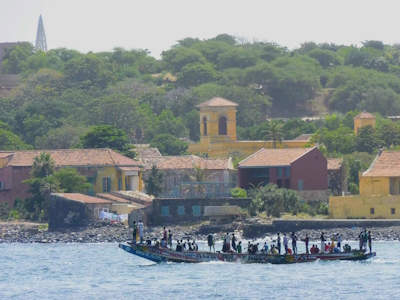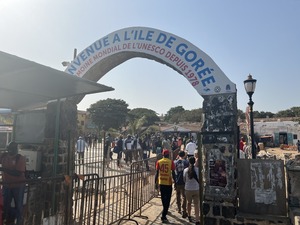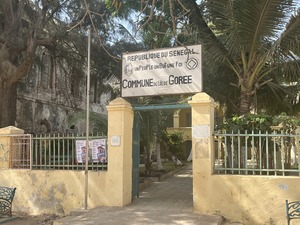Island of Gorée

The Island of Gorée is a place of memory for the Atlantic slave trade.
With its strategic location and safe haven, it was one of the first African places to be settled by Europeans. It became a warehouse for slaves brought from the African hinterland to work on the island and be transported to the Americas. It now is a place of memory for the African diaspora.
Community Perspective: It’s not an undisputed place as the need for a tangible memorial precedes historical accuracy. See Solivagant’s review for more details. The island is a fine and easy half-day trip from Dakar - see Els's review for practical details.
Map of Island of Gorée
Community Reviews
Els Slots

It’s just a 20-minute walk from the center of Dakar to the ‘Gare Maritime’ from where the ferries to Gorée leave. This is a well-organized service, with online timetables, clear ticket prices (unchanged for years so it seems, 5200 XOF for the return plus 500 tax), and a boarding area with plenty of seats and a French bakery. It's nothing like the Elephanta ferry I took a month ago from Mumbai – with its lack of signage, old wooden boats and the dirt all around. Just don’t forget to bring your passport here, as it will be checked when you enter the harbour area. If you want to sit at the ferry's top deck, enter via the back entrance and choose a seat on the right for the best Gorée arrival views (I sat on the left, staring at a Maersk containership). The crossing takes just 20 minutes.
The core zone comprises the whole island, which measures about 900x350m. Right off the boat, you walk underneath a Welcome to Gorée-sign that doubles as a Plaque. Check! There’s no shortage of UNESCO WH emblems on display around the island anyway, they are also present on every information panel and at the town hall (hand-painted).
Gorée is a pleasant place to roam around on your own. There are no cars and no persistent sellers or wannabe guides. It has many picturesque small alleys worth checking out. Most buildings date from the late 18th and 19th centuries and were built by the Franco-African Creole, or Métis, community of merchants. These colourful buildings have been preserved well, at least in their facades. At the island's fringes, some are crumbling away, and squatters (handicraft sellers who started to stay overnight at the island and brought goats) have taken over the empty shells.
I found the two outermost points of the island the most interesting. At the southern tip, there is a gun battery dating back to WWII and the controversial Gorée-Almadies Memorial (a concrete construction added in 1999; ICOMOS got all hysterical about it for years but now seems to have given up). Walking up and down that area until the football field you'll have good views.
At the opposite end of the island, you’ll find the Fort d'Estrées. This French colonial structure has been turned into a History Museum. I was the only visitor here. After paying the 3000 XOF entrance fee, I was kitted out with an iPad audioguide in English to talk me through the 12 exhibition rooms. The museum highlights the history of the whole of Senegal (not only Goree) and I found it quite interesting. No overblown statements like Gorée being “the largest slave-trading centre of the African coast” are to be found here.
I choose not to visit the “House of Slaves” elsewhere on the island, and overall, the appeal of the fabricated Slavery Site of Memory which was aimed at the African-American clientele seems to have faded away a bit in favor of the needs of the average French tourist.
I returned to Dakar with the 2 pm ferry, after having arrived around 10.30. It takes 1.5-2 hours to cover the island in detail and visit the museum. Afterward, I had a decent lunch of grilled fish in one of the many restaurants on the island. You can also stay overnight, there are a couple of hotels.
Read more from Els Slots here.
Michael Novins

I spent several days in Dakar in June 2018. On my first morning, I caught an early ferry to Île de Gorée, which, at least according to UNESCO, was the largest slave-trading center on the African coast from the 15th century to abolition in the 19th century. Although many historians disagree with that assessment, Île de Gorée has become an essential stop for the African diaspora, including President and Mrs. Obama, who visited the Maison des Esclaves and its windowless cells and “door of no return” in 2013. I also visited the slave house, even though academics have generally agreed since the 1990s that the house was more likely to have been a private home than to have been involved in the slave trade. Whether or not Île de Gorée played an important role in the transatlantic slave trade, the small island has become a moving place to contemplate the human toll of African slavery.
Solivagant

Goree is a small pleasant island situated a 30minute ferry ride offshore from crowded ugly Dakar. Free of vehicles, its sandy streets are lined with pleasing old houses and flowering shrubs. There is a fort, a castle (with some impressive early 20th century gun emplacements) and several restaurants – in its own right it deserves a visit if you are in Senegal. BUT – beyond these anodyne aspects, lies its claimed “history” as a centre of the Atlantic slave trade and its subsequent emergence as “a memorial to the African diaspora (which) continues to serve as a reminder of human exploitation and as a sanctuary for reconciliation.” (UNESCO long description).
The central point for this “memorial” is the “Maison des esclaves” (photo). Within you will be shown what are said to be slave prison rooms and the “gate of no return” through which slaves were sent to the Americas. You will be regaled with details of the undoubted horrors of the slave trade. You will be shown plaques commemorating the visits of numerous world leaders – a visit is de rigeur for any such person visiting Senegal – Mandela, the Clintons, George W Bush and Pope John Paul II among them.
However, whether this building was ever a slave trading prison and, indeed, whether Goree itself was ever a significant entrepot of the trade is a matter of considerable doubt. But beware - to question any of this is regarded by some as the equivalent of being a holocaust denier!
Another quote from the UNESCO description states “it was the largest slave-trading centre on the African coast. An estimated 20 million Africans passed through the Island between the mid-1500s and the mid-1800s. Ruled in succession by the Portuguese, Dutch, English and French, its architecture is characterized by the contrast between the grim slave-quarters and the elegant houses of the slave traders.”
It is amazing that UNESCO should carry such unsupportable statements on its Web site – the inscription of Goree dates right back to 1978 and there is no objectively assessed nomination file or AB evaluation on file. However all the facts about the Atlantic slave trade and its geographic spread over time from Senegal round to Angola involving a number of European states, together with the likely maximum and minimum numbers involved indicate that such a number could certainly NOT have passed through Goree – or in all likelihood even from all the other locations involved! And indeed the Maison des esclaves looks far more like an example of the “elegant house” than of a “prison” – especially if you ignore the modern iron bars! Anyone interested in researching the subject can find plenty of material on the history of the house, its development into a museum and tourist site and its elevation as a powerful symbol disassociated from its real history.
I personally disliked being “manipulated” by all this ersatz “cod history” and Goree has joined my list of similarly tendentiously presented sites (e.g Genbaku Dome). But factual truth is not the issue here – Goree has become a shrine and to question its historical “details” is as pointless as going to Lourdes and questioning the reality of miracles. The interest lies more in its contemporary role as a cultural icon – for the Black Diaspora, for Black Africa and for “guilt ridden” Europeans and Americans. If you want to see a site whose physical connection to the Atlantic slave trade is undoubtedly significant and genuine go to some of the “Gold Coast Forts and Castles”. Their presentation of the historical background also contains its propagandist aspects – but, at least, the sites' historic credentials are genuine.
Community Rating
- : Liverpool1023 Fmaiolo@yahoo.com
- : David Marton
- : Gary Arndt Adrian Turtschi Rickard Alfredsson Ctravel George Gdanski Tevity Zsuzsanna Forray
- : Szucs Tamas Thomas van der Walt Philipp Leu Rvieira Krijn
- : Alexander Barabanov Stanislaw Warwas Els Slots Christoph Joyce van Soest Dorejd Riomussafer Jeanne OGrady GerhardM Gilles Kevin247
- : Roger Ourset Tony0001
- : Jon Opol Don Irwin
- : Solivagant
- : Richardleesa Mikko
Site Info
- Full Name
- Island of Gorée
- Unesco ID
- 26
- Country
- Senegal
- Inscribed
- 1978
- Type
- Cultural
- Criteria
-
6
- Categories
- Human activity - Transport and Trade
- Link
- By ID
Site History
1978 Inscribed
Site Links
Connections
The site has 32 connections
Constructions
Damaged
Geography
History
Human Activity
Individual People
Religion and Belief
Timeline
Trivia
Visiting conditions
WHS Names
WHS on Other Lists
World Heritage Process
Visitors
107 Community Members have visited.
The Plaque
 (photo by Els)
(photo by Els) (photo by Els)
(photo by Els)